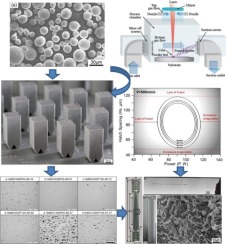当前位置:
X-MOL 学术
›
J. Mater. Process. Tech.
›
论文详情
Our official English website, www.x-mol.net, welcomes your
feedback! (Note: you will need to create a separate account there.)
Densification behavior of pure Zn metal parts produced by selective laser melting for manufacturing biodegradable implants
Journal of Materials Processing Technology ( IF 6.7 ) Pub Date : 2018-08-01 , DOI: 10.1016/j.jmatprotec.2018.03.007 Peng Wen , Lucas Jauer , Maximilian Voshage , Yanzhe Chen , Reinhart Poprawe , Johannes Henrich Schleifenbaum
Journal of Materials Processing Technology ( IF 6.7 ) Pub Date : 2018-08-01 , DOI: 10.1016/j.jmatprotec.2018.03.007 Peng Wen , Lucas Jauer , Maximilian Voshage , Yanzhe Chen , Reinhart Poprawe , Johannes Henrich Schleifenbaum

|
Abstract A lot of recent studies have shown that Zn based metals exhibit promising application prospects for biodegradable medical implants. Only a handful of recent reports can be found on additive manufacturing of Zn metal. Either the obtained density was quite low, or the process window was quite narrow due to severe evaporation. This paper aims to clarify the effect of processing parameters on densification behavior during selective laser melting (SLM) of pure Zn, and obtain high density in a reasonable process window. Single track melting and preliminary experiments were used to understand the process at first. Response surface methodology (RSM) was used to further investigate the effect of parameters on densification. A reasonable process window of high density over 99.90% was predicted and verified. Porosity was resulted by either lack of fusion due to insufficient laser energy or by gas entrapment due to excessive evaporation. For SLM parts of high density, the mechanical properties were measured as 46.31 ± 2.02HV, 20.47 ± 5.71 GPa, 122.13 ± 2.61 MPa, 137.9 ± 2.48 MPa and 8.13 ± 0.55% respectively for hardness, Young’s modulus, Yield strength, ultimate strength and elongation. The paper provided processing knowledge on SLM of Zn metal and solved the most difficulty dealing with laser melting of Zn metal: low densification, thus paved the way for additive manufacturing of Zn based metals for biodegradable implants.
中文翻译:

选择性激光熔化制备可生物降解植入物的纯锌金属部件的致密化行为
摘要 近年来的大量研究表明,锌基金属在可生物降解医疗植入物方面具有广阔的应用前景。最近关于锌金属增材制造的报道很少。要么获得的密度很低,要么由于蒸发严重,工艺窗口很窄。本文旨在阐明加工参数对纯锌选择性激光熔化 (SLM) 过程中致密化行为的影响,并在合理的工艺窗口中获得高密度。首先使用单轨熔化和初步实验来了解该过程。响应面方法 (RSM) 用于进一步研究参数对致密化的影响。预测并验证了超过 99.90% 的高密度的合理工艺窗口。孔隙率是由于激光能量不足导致缺乏融合或由于过度蒸发造成的气体截留造成的。对于高密度的 SLM 零件,硬度、杨氏强度、极限强度和屈服强度的机械性能分别测量为 46.31 ± 2.02HV、20.47 ± 5.71 GPa、122.13 ± 2.61 MPa、137.9 ± 2.48 MPa 和 8.13 ± 0.55%伸长。该论文提供了锌金属SLM的加工知识,解决了锌金属激光熔化的最大难点:低致密化,从而为用于可生物降解植入物的锌基金属的增材制造铺平了道路。硬度、杨氏模量、屈服强度、极限强度和伸长率分别为 48 MPa 和 8.13 ± 0.55%。该论文提供了锌金属SLM的加工知识,解决了锌金属激光熔化的最大难点:低致密化,从而为用于可生物降解植入物的锌基金属的增材制造铺平了道路。硬度、杨氏模量、屈服强度、极限强度和伸长率分别为 48 MPa 和 8.13 ± 0.55%。该论文提供了锌金属SLM的加工知识,解决了锌金属激光熔化的最大难点:低致密化,从而为用于可生物降解植入物的锌基金属的增材制造铺平了道路。
更新日期:2018-08-01
中文翻译:

选择性激光熔化制备可生物降解植入物的纯锌金属部件的致密化行为
摘要 近年来的大量研究表明,锌基金属在可生物降解医疗植入物方面具有广阔的应用前景。最近关于锌金属增材制造的报道很少。要么获得的密度很低,要么由于蒸发严重,工艺窗口很窄。本文旨在阐明加工参数对纯锌选择性激光熔化 (SLM) 过程中致密化行为的影响,并在合理的工艺窗口中获得高密度。首先使用单轨熔化和初步实验来了解该过程。响应面方法 (RSM) 用于进一步研究参数对致密化的影响。预测并验证了超过 99.90% 的高密度的合理工艺窗口。孔隙率是由于激光能量不足导致缺乏融合或由于过度蒸发造成的气体截留造成的。对于高密度的 SLM 零件,硬度、杨氏强度、极限强度和屈服强度的机械性能分别测量为 46.31 ± 2.02HV、20.47 ± 5.71 GPa、122.13 ± 2.61 MPa、137.9 ± 2.48 MPa 和 8.13 ± 0.55%伸长。该论文提供了锌金属SLM的加工知识,解决了锌金属激光熔化的最大难点:低致密化,从而为用于可生物降解植入物的锌基金属的增材制造铺平了道路。硬度、杨氏模量、屈服强度、极限强度和伸长率分别为 48 MPa 和 8.13 ± 0.55%。该论文提供了锌金属SLM的加工知识,解决了锌金属激光熔化的最大难点:低致密化,从而为用于可生物降解植入物的锌基金属的增材制造铺平了道路。硬度、杨氏模量、屈服强度、极限强度和伸长率分别为 48 MPa 和 8.13 ± 0.55%。该论文提供了锌金属SLM的加工知识,解决了锌金属激光熔化的最大难点:低致密化,从而为用于可生物降解植入物的锌基金属的增材制造铺平了道路。











































 京公网安备 11010802027423号
京公网安备 11010802027423号